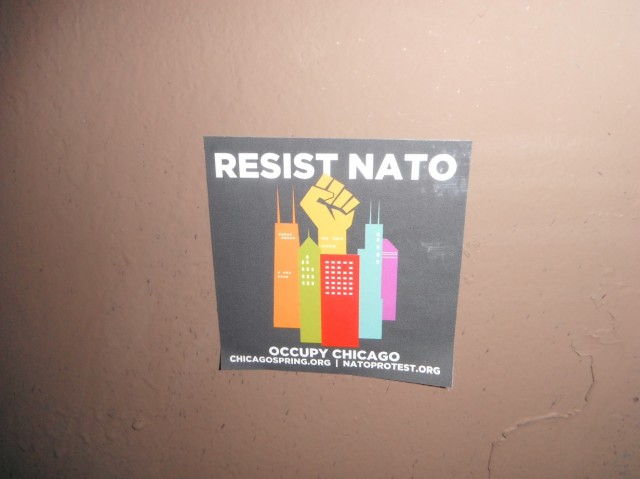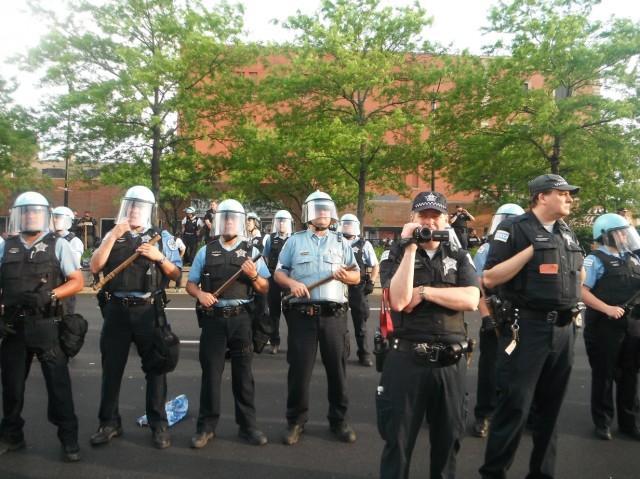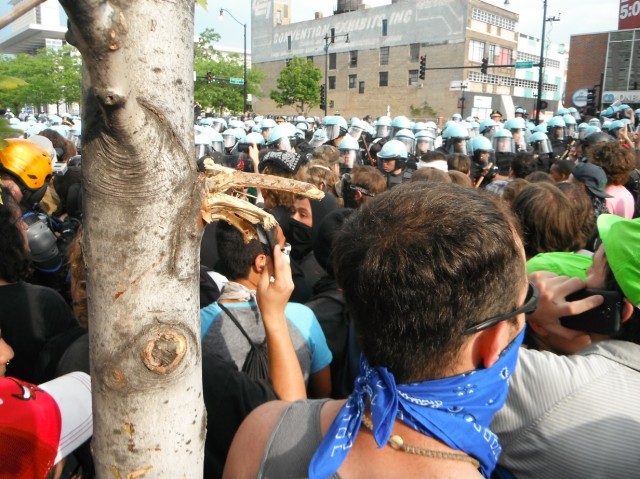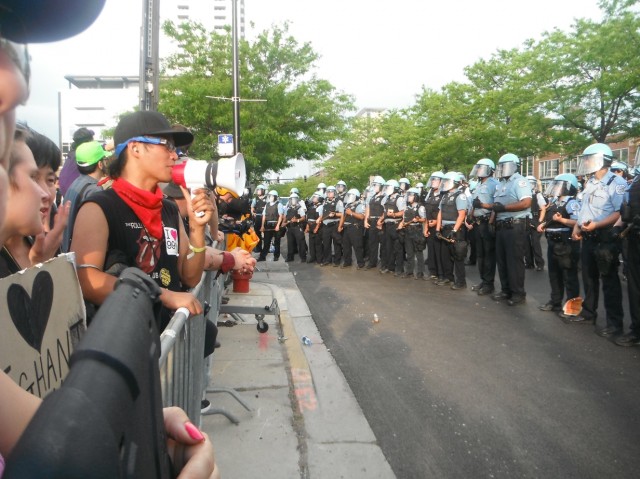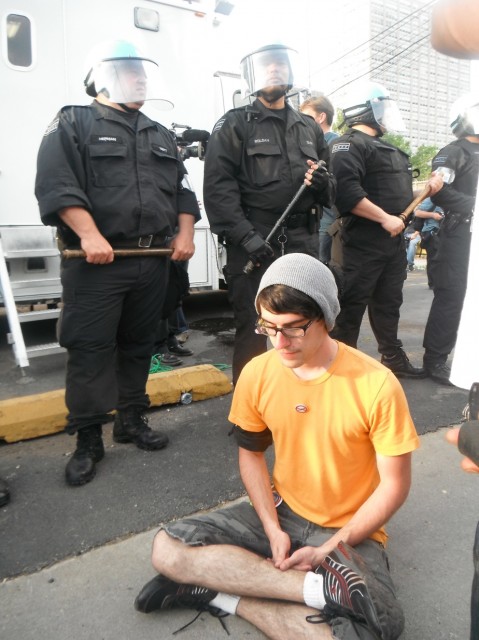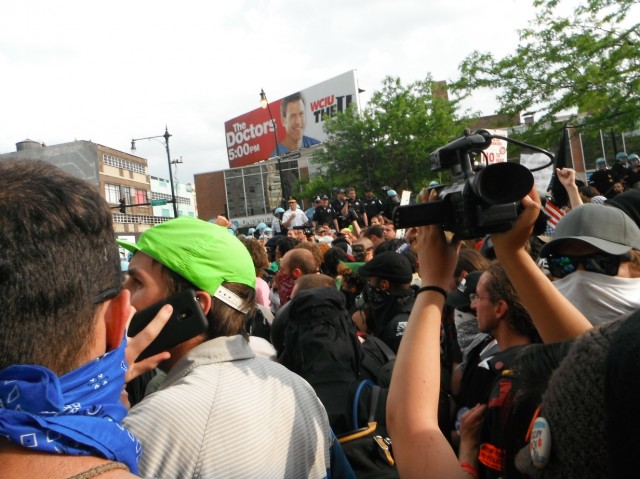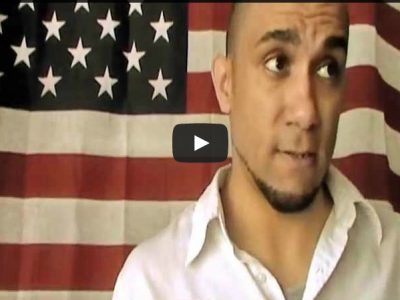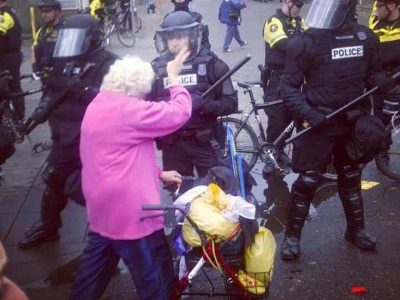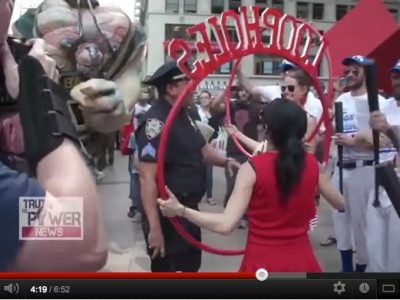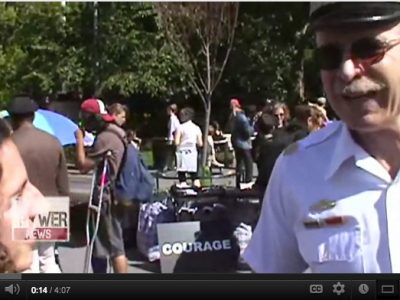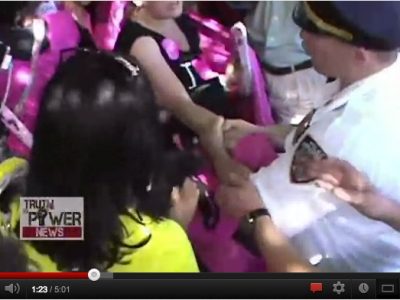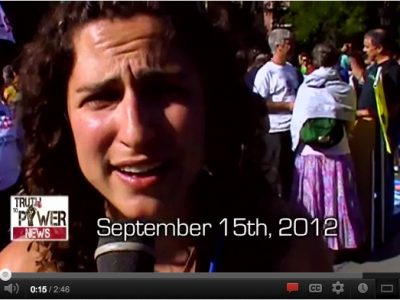Story and Photographs by @CarrieFoTruth
When I left for the NATO summit, I expected the police in Chicago were going to be oppressive against protesters, if not downright violent. There had been quite a bit of media buzz around the Chicago Police Department having spent a million dollars on riot and tactical gear, as well as them announcing they had an LRAD (long-range acoustic device), a military weapon capable of emitting painful noises to disburse crowds. Residents of Chicago had been advised to not wear suits (so as not to enrage the protesters), stay indoors, have food and water on-hand, and even to leave town if possible. From my perspective, this was obvious fear-mongering on the part of the police. There was little reason to believe that a peaceful anti-war protest was going to turn into the LA riots. I had no idea, however, how the police were going to act.
I have been to many protests, mostly in Portland, Oregon, since the year 2000 at the age of 16. It was there on March 20, 2003 when 10,000 people rallied against the Iraq war joining millions worldwide, and later took to the streets. I was with the group that sat in the intersection of Burnside & 2nd, while police used concussion grenades, rubber bullets, batons, and pepper spray to disperse the peaceful crowd. It was then that I realized that our so-called “rights” of free speech and assembly were only there in theory. When they are exercised, they turn into a privilege: one to be revoked by the state at any time.
Fast-forward to 2011, when my involvement with Occupy started. Living at the encampment at Occupy Portland I was in contact with police on a daily basis. I watched as crimes there went uninvestigated, even as we asked police for help. I have seen protesters pepper-sprayed, beaten, and abused by police. I have seen thousands forcibly removed from parks, streets, and sidewalks. I understand the brute force that the police can use if they wish. Still, I have never seen anything like the Chicago NATO protests of 2012.
To start with, the enormity of the crowd was new to me. I have marched with crowds of 2, 7, even 10 thousand on a few occasions. The crowd on May 20th was several times bigger than anything I have ever experienced: massive, in every sense of the word. Estimates have ranged from 1,800 to 75,000, although estimates reported by most mainstream outlets stayed closer to the 2,000 – 15,000 range. I find it peculiar, even for mainstream media, to underplay a crowd of this proportion by this large of a margin. In past marches in Portland, the media has claimed far fewer of us than actually there, and then we have overheard a much more accurate crowd estimate on a police scanner. These tactics are typical of MSM and not surprising for a corporate-owned media, but the crowd estimate in this case is not just a misrepresentation of the crowd on May 20th; it is a giant lie. Judging from my experiences, the crowd was at least 30,000 people, if not larger.
The rally started in Grant Park at noon. Already, the temperature was a sweltering 89 degrees, and much hotter anywhere near the asphalt. In front of the main stage was a large space in direct sunlight, making it difficult to stay there for very long. Most participants sought relief in the trees surrounding the space, listening to the rally over the very loud and clear PA system that had been set up. There were many speakers, representing immigrant rights, environmental protection, unions, LGBT issues, governmental reform and more. Each had a message that tied into why their organization was opposed to NATO; from wars to global imperialism to the violation of international laws. The last speaker was Rev. Jesse Jackson who said, “We need a peace machine, not a war machine,” referring to NATOs actions abroad. During the latter half of his speech the crowd started assembling for the 2-mile march that lay ahead. There was an air of excitement. Banners flew, children ran around joyfully with balloons, and people packed the streets, starting to chant, “What do we want? NO NATO! When do we want it? NOW!”
The march was long and very peaceful. Along the parade route were thousands of police. At first, they appeared in regular police uniforms, then they had batons, then they appeared holding their batons as if ready to use them. As we progressed, they appeared more and more suited up, as if each street we passed meant marching deeper and deeper into a police state.
Eventually I got heat-sick from the direct sunlight. I started to feel faint, and told my viewers on Ustream that I needed to take a break since I didn’t feel well. Before I knew it I was being lowered to a sitting position on the ground by two nice people, who prevented me from fainting on the sidewalk and called for a medic. I was treated by two of Occupy’s finest: Oakland Elle and Occupy Medic 1 from Oakland, CA. After a dose of electrolytes, some fresh water, a Luna bar, and an instant ice pack to the neck I was feeling so much better. About 15 minutes later the EMTs working for the fire department showed up. They had me sign a release form saying I “refused treatment” which I found sort of strange because by then I didn’t need treatment anymore. After the EMTs took off, I heard over the loudspeaker the start of the veteran’s rally. I happened to be on the corner of Michigan and Cermak, where the war veterans were giving their medals to NATO as a sign of protest against the wars, and the pain and suffering they have caused.
The rally was the most emotionally moving one I have ever been witness too. Many people in the crowd, including myself, were teary-eyed hearing the personal accounts from former soldiers and women from Afghanistan. One woman said, “All we have is this flag, but not our sovereign land. I’d like to direct my message to the NATO representatives here in Chicago today. For what you’ve done to my home country, I’m enraged; for what you’ve done to my people, I’m disgusted; for what you’ve done to these veterans, I’m heartbroken.” Many soldiers told their stories. Some talked about how they were forced to kill innocent people, many mentioned the physical and emotional trauma they suffered from their service, others shared their apologies and hopes for a better future. As one veteran gave back his medals he said, “No amount of medals, ribbons, or flags can cover the amount of human suffering caused by this war.” Another said, “I have only one word, and it is shame.” Another broke down in tears and could only say “I’m sorry. I’m fucking sorry.”
When they were done, we took a moment of silence. A horn played, the former soldiers lined up in two neat rows and prepared to leave together. The rally was wrapping up, and one of the veterans suggested on the loud speaker that the crowd start moving west, toward the buses and restaurants. People started to slowly make their way toward the western direction, realizing that the police were now blocking everyone north of Cermak from going back the way they came, and blocking every direction besides west. The people with me in the area directly on the corner of Michigan & Cermak were now stuck, waiting for thousands to start moving one direction before we could hope to get out of an artificially narrowed space packed with people, created by rows of police in riot gear. A few minutes later, I was still video streaming when about 20 officers marched single-file, in full riot gear, and started pushing into the crowd, coming from the west. It was strange to see officers advance into a crowd, going against the flow of foot traffic. And that’s when things got crazy.
When the last officer in line was about ten feet from me, I heard screams of pain, then shouts of anger, and then multiple cries, “Medic!” then more panicked cries from farther towards the front of the police line, “MEDIC!!!” Then we started to see them; one on my left, then two to my right; people bleeding profusely down the side of their heads, other with bloodied faces. The crowd panicked.
I was immediately swept up in a crowd that was scrambling over one another, trying to escape, but there was no way out. I was at one point pressed so tightly in the crowd that my feet were lifted off the ground and I was carried by the sheer pressure against my sides and ribcage several feet. At several points I heard myself cry out as my ribs had sharp pains in them, and my feet were trampled upon. It was chaos. People screamed “Which way do we go?!” with panic written all over their faces. People tried leaving in any way they could, only to be stopped in every direction. A woman with a young child yelled, “Get us out of here!” People twisted and groaned against the weight of the crowd, trying to help her and her child out.
In the midst of the chaos a man climbed up on two metal barricades that lay stacked on their sides, dismantled by the panicked crowd, trying to leave. He began to play his acoustic guitar. The scene suddenly became very surreal. The music was pure, calming, upbeat even, but the very fact he chose to play it right then, right there, made it an act of defiance. The disconnect between what I was hearing and what I was seeing made the situation seem like something out of a movie. The guitar player was eventually forced to move by the swelling crowd, but his song will stay with me forever.
The majority of people attempted to go west, but many turned around or stopped due to the heavy police presence in that direction, fearing the brutality they had just witnessed. A few seemed shell-shocked, standing still and slack-jawed as others pushed past them near the alley way where medics were giving first aid to some of those injured. It was as if the sight of all that blood turned off their ability to function altogether. I interviewed two different eyewitnesses while streaming about what had happened. They both said that the police just pushed through and started hitting people, completely unprovoked.
The main group of riot police forming a line parallel to Michigan avenue about ten officers deep, used this opportunity to advance several feet into the crowd, using their shields to butt up against those unfortunate enough to be near them at the time, shouting “Move! Move! Move!” in unison, as if they had anywhere to go. Every time they did this, people were trampled, smashed, hurt. I was pushed into the stacked metal barricades, and sustained injuries to my leg. A woman fell beside me, landing on the barricade with her hands and head. About the third or fourth time the police pushed forward, the people immediately near them started to push back. A group of about ten people all pushed toward the police at once, catching them off-guard, causing them to take a few steps back. They immediately moved forward with a vengeance, viciously beating every person they could get their hands or batons on. At some point a few people up front hit the helmets of officers with the thin wooden sticks from protest signs, and a couple people in the back threw empty plastic water bottles. It only enraged the police further, unleashing a beating on a new front row of people, since most of the original front row was now seeking medical care for serious injuries. A group of protesters dressed in black picked up the barricades that people were falling on, and started moving them through the crowd, creating a barrier between them and the police. This allowed a reprieve, as some people were able to get farther away from the police at that point. Those barricades were promptly removed from their possession with force. A man with a bullhorn warned the crowd that the LRAD was coming, and told everyone to put in earplugs if possible.
A young man with a red bandana around his neck and a Spanish accent addressed the police with his bullhorn. “You don’t have to do this, ” he said. “You can disobey orders that you know are unconstitutional.” He proceeded to tell them why he was there; that he wanted a better world, one where we could stop the wars, stop the killing and spend that money on better things. He told them he wanted a world where his mother could get proper healthcare and not die due to her insurance company denying her treatment. He choked up, and a couple members of the crowd laid a consoling hand on his shoulder.
It was then the crowd heard a dispersal order over the LRAD from the Chicago Police Department. We were told that our conduct was unlawful, and warned that we could be subject to removal, noise, or other police actions if we remained.
The crowd was starting to be able to move away from the police, as more people left down Cermak road to the west. A crowd of a few hundred stayed: I was one of those people. At that point I felt an obligation to film the encounter, hoping that more cameras would encourage less police violence, or at least help later in court cases, since many victims of police brutality are later taken into custody and charged with various crimes. I was able to remain on the sidewalk; doing my job as a journalist, although I was aware that if mass arrests were made it was likely I would be beaten or arrested with the rest of the crowd. Just as many still think we have a freedom to assemble and address our grievances, many people still believe we have a freedom of press in this country. As a member of the alternative media, I can assure you: those people are mistaken.
The police put on gas masks at several points, and protesters reacted by passing around baggies of cider vinegar, covering their nose and mouths with bandanas and paper masks, and a few donned their own gas masks or respirators. I was caught unprepared, so I tied my sweater around my neck, soaking it in vinegar that a young man in black handed me, trying not to choke on the fumes, and hoped for the best. The police continued to push forward, shouting, “Move! Move! Move!” in unison as they pushed protesters toward Cermak road. When they had reached the end of the intersection, where Michigan Avenue stopped and Cermak started, they sent more officers to the sidewalk as well, pushing and shoving those of us that were standing there; mostly members of the alternative media, and a few mainstream reporters and cameramen. Some of us were caught off-guard; many began to angrily complain that standing on a sidewalk to film was perfectly legal. Only one officer responded. He said curtly, “You’ve been ordered to disperse. Go.” The police proceeded to push and shove about ten more feet and came to a stop on the sidewalk, but continued in that fashion until they had completely cleared the street. Then, in an ironic twist, there was no one left but those of us on the sidewalk, and it was us that faced arrest, less lethal munitions, or “other police actions”.
There was a line of police on two sides, a solid building with no entrance on the other side, and a narrow passageway to leave, lined with sneering police in riot gear. Almost the entire crowd had left at this point, leaving about 45 people on the sidewalk to fend for themselves. A third and final dispersal order was given, and those who remained were warned they would face arrest if they continued to stay. One young man sat down on the sidewalk directly in front of the police and appeared to pray or meditate. The police, who had remained still and seemed stone-like up until this point noticed him, and for a split second I watched their expressions change to something resembling reflection.
The streets were empty of protesters and now full of bored-looking riot police who had been littering hundreds of Dasani water bottles and some wrappers from the White Castle burger joint all over the road.
Eventually there were around 15 people left on the sidewalk with me, including two National Lawyers Guild members who were speaking to those who remained. I walked over to the small group who were neatly seated in a square on the sidewalk and interviewed a young man. I asked him if his act of sitting on the sidewalk signified that he was willing to be arrested. He told me that he didn’t want to be arrested, since all he had done was stand and then sit on a sidewalk, but that he wasn’t willing to give up his right to do that, come what may. I wished him luck and walked about 15 feet further down the sidewalk to continue filming. The police started to assemble and march west down Cermak. A few were brave enough to cheer, and got threatening looks from police nearby. In groups of ten to about 50, the officers left the area, boarding various cars, vans, and metro busses parked down the street.
I walked up to the last few remaining individuals and I asked them how it felt to be the only ones who stood up for their constitutional rights. I got a few smiles, two peace signs, and a solidarity fist. They were exhausted, but victorious. It was Mark Twain that said, “A patriot is merely a rebel at the start. In the beginning of a change the patriot is a scarce man, and brave, and hated and scorned. When his cause succeeds, the timid join him, for then it costs nothing to be a patriot.” The NATO protesters seemed optimistic that someday the masses will join this cause. Let’s hope by then it’s not too late.
Carrie Medina is a Citizen Journalist, Streamer, and Editor who is an active member of Occupy Portland. Carrie worked in social science research prior to her current positions. She received a BA in 2006 with honors in Psychology & German and received her BS with honors in 2010 in General Science, Social Science, and Liberal Arts from Portland State University. Carrie’s hobbies include research writing, public health advocacy, and gardening. You can follow her @CarrieFoTruth on Twitter, and find her stream at http://www.ustream.tv/channel/occupypdxnews.
Carrie is also raising funds for her current trip to the 2012 Bilderberg meetings in Chantilly, Virginia, so if you like her work, please consider helping her out at her WePay donation site.

